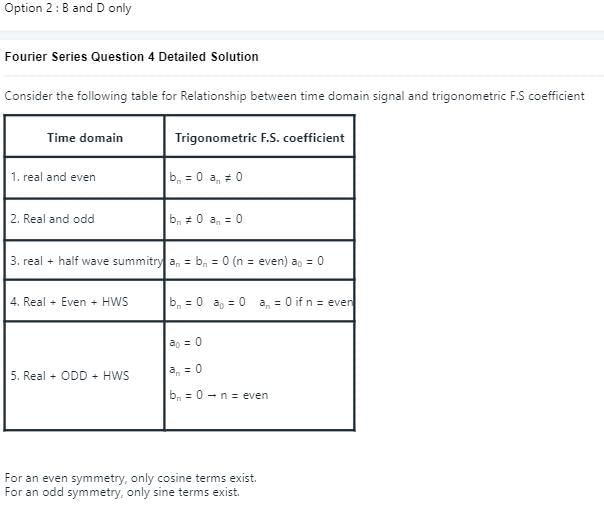Test: Signals And Systems & Microprocessors - 1 - Electronics and Communication Engineering (ECE) MCQ
15 Questions MCQ Test GATE ECE (Electronics) Mock Test Series 2026 - Test: Signals And Systems & Microprocessors - 1
In a continuous time system x(t) and y(t) denotes the input and output respectively then which of the following corresponds to a casual system?
Which of the following statements regarding the Fourier series are correct?
A. For an even symmetry, only sine terms exist.
B. For an even symmetry, only cosine terms exist.
C. For an odd symmetry, only cosine terms exist.
D. For an odd symmetry, only sine terms exist.
Choose the correct answer from the options given below:
The Laplace transform of a continuous-time signal x(t) is
If the Fourier transform of this signal exists, then x(t) is
The ROC for the Laplace transform of signal
x(t) = e-2t {u(t) — u(t — 5)] is given by
Under what condition the energy of signal g1(t) and g2(t) equals to E91 + Eg2
The signal V(t) = cos 5 πt + 0.5 cos 10 πt,is instantaneously sampled. The interval between the samples is 'TS'. Then the maximum allowable value for 'Ts' is
Match List-I (Type of Addressing Modes)
with List-II (Instructions set) and select the correct answer using the codes given below the lists:
List-I
-
Implicit addressing mode
-
Direct addressing mode
-
Register indirect mode
-
Register addressing mode
List-II
-
MOV A, M
-
MOV A, B
-
CMA
-
STA 2700H
Codes:
Consider the following statements:
- Programme Status Word (PSW) = Accumulator + Flag Register + Program Counter
- Program counter is a 16-bit register.
- Stack pointer operates as last in last out.
- "TRAP" is both level and edge sensitive. Which of the statements are false?
In priority orders, the interrupts in microprocessor are as
A memory chip of size 4 k byte has starting location 2000H. The last location of memory chip is given by
The 8085 assembly language instruction that stores the content of H and L register into the memory locations 2050H and 2051H, respectively is
The following program is run on an 8085 microprocessor:
Memory Address Instruction
(in hex)
3000 LXI SP, 4000
3003 PUSH H
3004 PUSH D
3005 CALL 3050
3008 POP H
3009 HLT
At the completion of execution of the program, the program counter of 8085 and stack pointer contains
15 8 memory chips of 64 x 4 bit size have address buses connected together. The resultant memory is
|
25 docs|263 tests
|




















